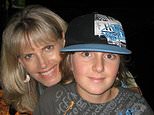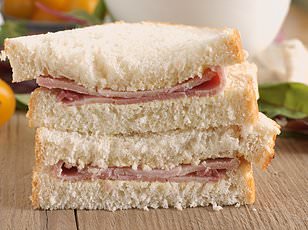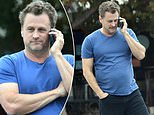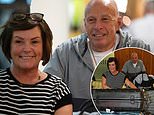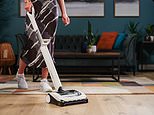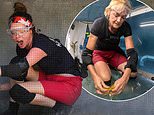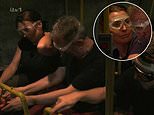The truth about Manchester City's Erling Haaland's outlandish health routine - as top goal-scorer splashes out £15,000 on red light therapy bed that he claims eases achy joints and prevents injury
He is the Norwegian goal machine that keeps breaking footballing records.
The £375,000-a-week striker Erling Haaland marked another landmark over the weekend as he took his Manchester City tally to 94 goals in 101 games, helping earn the Premier League champions a win against Ipswich Town.
'These are the numbers of Messi and Cristiano Ronaldo,' his manager Pep Guardiola said last week.
The 6ft 4in 24-year-old, dubbed 'the terminator', has followed a host of quirky health routines for years, credited with giving him an edge over his rivals.
These include eating beef heart and liver, using mouth tape and even installing a £50,000 cryochamber in his house to help his body recover.

Manchester City striker Erling Haaland, dubbed 'the terminator', has followed a host of quirky health routines for years, credited with giving him an edge over his rivals
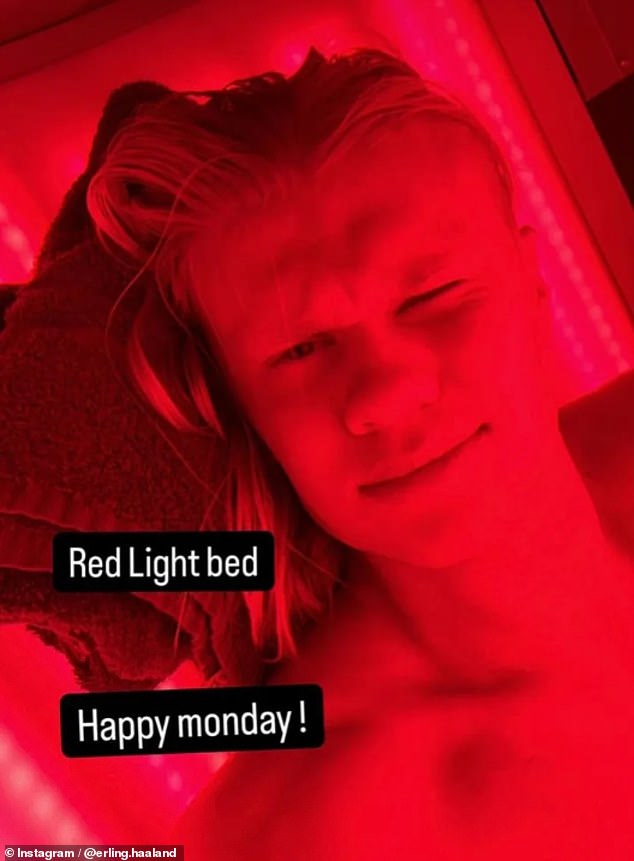
Now the top goalscorer has also shared extra insight into his daily routine, last week sharing photos of a £15,000 red-light therapy bed
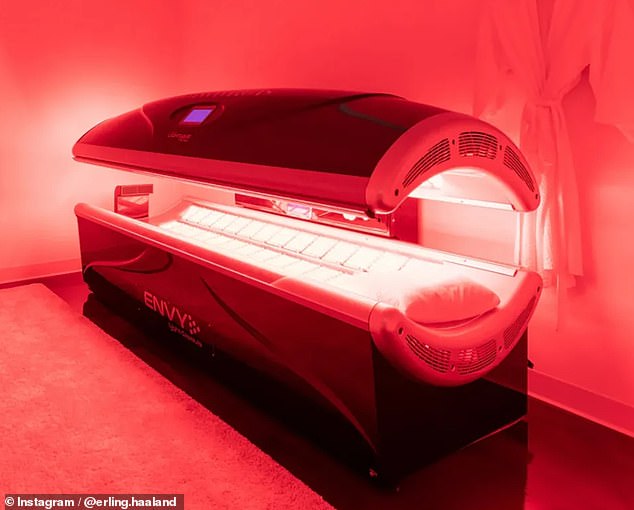
Advocates say light-emitting diodes (LEDs) can repair damaged tissue, calm the body's response to injury and reduce inflammation. Experts have previously recommend a five-minute session before workouts to help prevent injuries, and then a further one of up to 20 minutes afterwards to aid muscle recovery
Now the top goal scorer has also shared extra insight into his daily routine, last week sharing photos of a £15,000 red-light therapy bed.
But are there any benefits to this device? And health effects does his quirky routine actually provide?
Here, MailOnline asks the experts and breaks down the science behind Erling Haaland's success.
Red Light Therapy Bed
Taking to Instagram this week, Haaland took a selfie inside the bed, captioning it: 'Red light bed. Happy Monday!'
The therapy uses infrared rays to penetrate deep into tissues and joints.
Advocates say light-emitting diodes (LEDs) can repair damaged tissue, calm the body's response to injury and reduce inflammation.
Experts have previously recommended a five-minute session before workouts to help prevent injuries, and then a further one of up to 20 minutes afterwards to aid muscle recovery.
Unlike UV light, which is associated with skin cancer and premature and accelerated aging, LED light is the visible spectrum of light.
Generally, red light therapy uses wavelengths of visible red light between about 630 to 700 nanometers, which penetrate the skin where cells can absorb it and stimulated energy production.
The treatment has also been used to treat pattern hair loss and alopecia and to reduce body fat.
One 2020 study published in the Journal of Drugs in Dermatology found LED phototherapy may be effective in treating ageing skin.
US researchers found red light therapy could boost fibroblasts — cells found in connective tissue — which help produce collagen and in turn gives skin its structure, strength and elasticity.
A 2015 systemic review investigating the effects of red light therapy on exercise also showed promising results for improving performance and aiding muscle recovery.
However, the evidence for exercise is promising, but not conclusive.
Overuse of devices could result in undesirable adverse events such as redness lasting longer than one day, blistering, burns, decrease in collagen, increase in wrinkles, experts have previously warned.
Professor Elma Baron, an expert in dermatology at Case Western University, also said: 'We know that red light has some beneficial effects in terms of promoting the growth of and maintaining healthy collagen in your skin.
'But of course, there are many other things that people are using red light for, and the evidence for those applications is not as strong.'

The £375,000-a-week striker Erling Haaland marked another landmark over the weekend as he took his Manchester City tally to 94 goals in 101 games, helping earn the Premier League champions a win against Ipswich Town. 'These are the numbers of Messi and Cristiano Ronaldo,' his manager Pep Guardiola said last week
A special diet of cow hearts and livers
It takes a lot to fuel the most dangerous striker in the Premier League.
The Norwegian attacker reportedly eats Cow liver, even devouring the heart too as part of his 6,000 calorie a day diet — around two-and-a-half times more than the average man should have.
In his documentary 'Haaland: The Big Decision' which aired in 2022 and followed his career before moving to Manchester City, he said: 'I think eating quality food that is as local as possible is the most important.
'People say meat is bad for you but which? The meat you get at McDonald's?
'Or the local cow eating grass right over there? I eat the heart and the liver.'
Eating offal — animal organs used for food — has become less common in recent times but once formed a core part of hunter-gatherer diet.
Heart is leaner than the majority of steaks, minces and other parts of the cow, while still being a rich source of muscle-building protein.
Registered nutritionist and author Rob Hobson told MailOnline offal 'does have a health benefit'.
He added: 'Both liver and heart are very nutrient-dense foods, meaning they provide a large amount of vitamins and minerals relative to their calorie content.
'Liver is one of the best sources of vitamin A, which is essential for eye health, immune function, and skin health.
'It is also high in B vitamins — especially B12, which is crucial for red blood cell formation, energy production, and neurological function — and an excellent source of heme iron.
'This is more easily absorbed by the body than non-heme iron found in plant foods and helps prevent or treat anemia.'
But, he added, offal contains more fat and saturated fat than leaner cuts of meat like chicken breast or beef steak.
'I would eat in moderation if you are going to do so given the high content of vitamin A,' he added.
His £50,000 cryotherapy chamber
In 2022 Haaland also secured his status as cooler than ever after buying a £50,000 cryotherapy chamber to stay in top condition.
The walk-in pod can hit temperatures of -200C (-328F) and requires protective mitts to be worn when in use. It pumps liquid nitrogen into the air surrounding the cylinder to cool the body and rehabilitate body tissue.
The chamber can only be used for a maximum of five minutes to prevent serious risks to health, including hypothermia and frostbite.
Cryotherapy, which is also loved by the likes of Usain Bolt, is thought to help reduce inflammation and injury swelling.
For these reasons, it relieves muscle pain and enhances recovery times after games and training.
The chambers also boost blood circulation, improve the immune system, decrease fatigue and help injuries heal more rapidly, advocates claim.
It is believed to stimulate the release of endorphins, which are natural painkillers and mood enhancers.
This can help the players feel more energised and mentally focused, which is important for their performance on the field.
Scientific consensus about cryotherapy is mixed, however.
Some experts say while there's no conclusive evidence that the tecnique works, it may act as a positive placebo, making athletes feel better and recover faster.
Doctors have also previously warned that those with diabetes and nerve conditions should not use the therapy, as they may not feel it working.

Appearing on Logan Paul's Impaulsive podcast last year, Haaland admitted he sleeps with mouth tape to maximise breathing through the nostrils

Last year he also told the Impaulsive podcast: 'The first thing I do in the morning is to get some sunlight in my eyes, it is good for circadian rhythm.' This has an important effect on the body, training it to wake up earlier the next day and sleep better
Mouth Taping
The striker also takes an unusual approach to sleep in order to aid his performance.
Appearing on Logan Paul's Impaulsive podcast last year, Haaland admitted he sleeps with mouth tape to maximise breathing through the nostrils.
'To do a lot of things is not good but to do small things every single day for a longer period really pays off,' he added.
Dozens of studies have suggested that breathing through the nose — which is what taping the mouth at night makes you do — will banish bad breath, stop you snoring and slash the risk of gum disease.
'People don't acknowledge that how they breathe can have a significant impact on their sleep quality, anxiety, respiratory disorders, like asthma, athletic performance, and more,' James Nestor, author of Breath: the new science of a lost art, also told MailOnline.
But taping the mouth overnight is undoubtedly dangerous, and it sparked warnings when the craze swept social media earlier this year.
It involves placing a piece of tape over their closed mouth — over both the upper and lower lip — before sleep, so a person can't easily open their mouth. The logic is that it prompts people to breathe through their nose while sleeping.
Hypoallergenic, surgical and athletic tape are often use for mouth taping but some specific products also exist.
However, taping the mouth can disrupt sleep by causing irritation, anxiety and difficulty breathing through the nose, warns the Sleep Foundation.
Experts also say that it could be dangerous and even life-threatening because a child with their mouth taped shut could choke on their vomit and die.
Professor Edzard Ernst, a leading expert in alternative medicines, formerly of Exeter University, said: 'I'm not aware of any reliable evidence to suggest that mouth-taping improves sleep, stops snoring, cures sleep apnoea, or helps with any other problem.'
However, for those who choose to tape their mouth, Mr Nestor advises using surgical tape across the centre of the lips, making sure to not seal the whole mouth.
The tape should come off easily and train the mouth to shut while you sleep, he says.

The Norwegian attacker reportedly eats Cow liver, even devouring the heart too as part of his 6,000 calories a day diet — around two-and-a-half times more than the average man should have
Blue light glasses and waking up with sunlight for circadian rhythm
It's not just mouth taping that ensures Haaland gets a good night's kip.
Last year he also told the Impaulsive podcast: 'The first thing I do in the morning is to get some sunlight in my eyes, it is good for circadian rhythm.'
This has an important effect on the body, training it to wake up earlier the next day and sleep better.
Circadian rhythm, the body's in-built clock, sets the rhythm of our lives.
It is a 24-hour internal clock in our brain that regulates cycles of alertness and sleepiness by responding to light changes.
Professor Russell Foster, a neuroscientist at the University of Oxford and one of the world's most renowned experts on circadian rhythms, told MailOnline: 'Light is critically important for setting the body clock.
'Morning light helps you get up earlier, while evening light trains the body to wake up later. Haaland will be playing evening games under flood lights, which would keep him up at night.
'By getting the morning light he is in a sense resetting the clock.'
Three hours before bedtime the Norweigan star also reportedly dons orange-tinted, blue-light glasses.
Later in the podcast, Haaland also said: 'I think sleep is the most important thing in the world.
'So to sleep good, simple kind of things blue blocking glasses, shutting out all the signals in the bedroom.
But the science is slightly less clear on how effective this is is.
Warnings over potential dangers of blue light have seen the glasses increasingly prescribed since the early 2000s.
Blue light pumped out by computers, tablets and phones is said to be ruining our eyesight by causing us to strain.
Some research has also suggested that exposure to blue light late at night can disturb sleeping patterns.
But a review of 17 trials last year rubbished marketing claims that such glasses protect against damage to the retina, the light-sensitive tissue at the back of the eye.
The research team, which included experts at City, University of London and Monash University, concluded: 'Our findings do not support the prescription of blue-light filtering lenses to the general population.'























